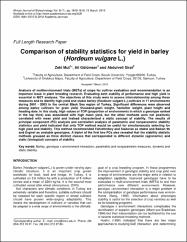Comparison of stability statistics for yield in barley (Hordeum vulgare L.)

View/
Access
info:eu-repo/semantics/openAccessDate
2010-03-15Access
info:eu-repo/semantics/openAccessMetadata
Show full item recordCitation
A1. Mut, Z., A. Gülümser, A. Sirat, 2010. Comparison of stability statistics for yield in barley (Hordeum vulgare L.). African Journal of Biotechnology Vol. 9(11), pp. 1610-1618, 15 March, 2010 Available online at http://www.academicjournals.org/AJB, ISSN 1684–5315 © 2010 Academic Journals.Abstract
Analysis of multienvironment trials (METs) of crops for cultivar evaluation and recommendation is an important issue in plant breeding research. Evaluating both stability of performance and high yield is essential in MET analyses. The objectives of his study were to assess interrelationship among these measures and to identify high-yield and stable barley (Hordeum vulgare L.) cultivars in 11 environments during 2001-2003 in the central Black Sea region of Turkey. Significant differences were observed among barley cultivars for grain yield, thousand-grain weight, hectoliter weight, plant height and heading date. In this study, high values of TOP (proportion of environments in which a genotype ranked in the top third) was associated with high mean yield, but the other methods were not positively correlated with mean yield and instead characterized a static concept of stability. The results of principal component (PC) analysis and correlation analysis of parametric and nonparametric stability statistics and yield indicated that only TOP method would be useful for simultaneously selecting for high yield and stability. This method recommended Fahrettinbey and Sladoran as stable and Balkan 96 and Erginel as unstable genotypes. A biplot of the first two PCs also revealed that the stability statistic methods grouped as three distinct classes that corresponded to different dynamic (agronomic) and static (biological) concepts of stability.

















